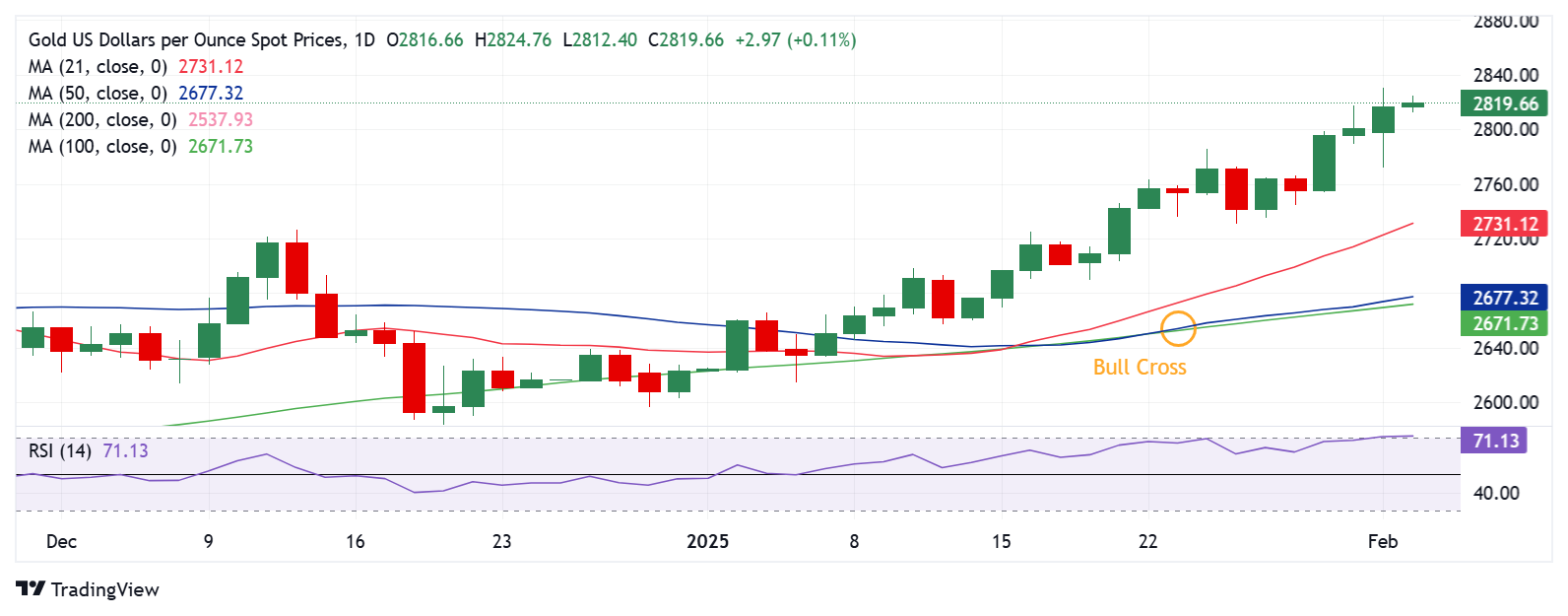- Gold price off record highs, consolidates recent gains above $2,800 early Tuesday.
- The US Dollar demand attempts a rebound in sync with US Treasury bond yields.
- US President Trump delays tariffs on Mexico and Canada, not on China.
- Overbought conditions on the daily chart caution Gold buyers ahead of US jobs data.
Gold price has entered a consolidative mode above $2,800 early Tuesday, slightly off all-time highs of $2,831 reached on Monday. Attention now turns toward the US labor data and speeches from US Federal Reserve (Fed) policymakers amid tariff respite by US President Donald Trump.
Gold price awaits US jobs data for fresh impetus
After witnessing an extremely volatile trading day on Monday, Gold price bides times as buyers take a breather, weighing the recent tariffs play by Trump amid strong US ISM PMI data and hawkish Fed commentaries.
Additionally, the US Dollar (USD) embarks on a decent recovery across its major currency rivals as markets remain wary heading into the US tariff implementation time on China from 5:01 GMT this Tuesday.
However, if the much-awaited US JOLTS Job Openings data, expected to arrive at 8 million in December, disappoints alongside the upcoming Fedspeak, the selling interest in the Greenback will likely be reinforced, allowing Gold price to pressure record high.
Further, if risk recovery gathers steam, markets are likely to dump the safe-haven US Dollar in search of higher returns in the global stocks, Gold price could find a fresh boost for a continued upside.
Gold price witnessed good two-way businesses on Monday, falling as low as $2,773 in the first half due to intense safe-haven flows into the US Dollar after traders took account of US President Donald Trump’s tariff announcements.
Trump on Saturday imposed 25% tariffs on Canada and Mexico while slapping China with 10% levy, citing that the measures were necessary to combat illegal immigration and the drug trade. The Trump tariff war rattled markets and pushed them to ‘sell everything’, with the Greenback emerging as the only winner.
However, the tide turned against the USD in Monday’s American trading after the US struck a deal with Mexico and Canada to delay tariffs by a month in exchange. for strict border security from both its neighbors and to ban fentanyl exports to the US.
Notwithstanding the sharp rebound in US Treasury bond yields, the renewed US Dollar sell-off helped push Gold price to fresh record highs at $2,831. Gold price, however, moved slightly away from the record highs to settle near $2,815 as Fed policymakers maintain their cautious outlook on inflation and interest rate cuts amid Trump’s policy uncertainty.
Atlanta Fed President Raphael Bostic said that “uncertainty has been increasing; want to be cautious and not have policy lean in a direction and have to switch.” “I’m prepared to wait for a while to cut again,” he added.
Meanwhile, Chicago Fed President Austan Goolsbee noted that “uncertainties warrant caution in rate cuts,” warning of “possible inflation increase.“
Gold price technical analysis: Daily chart
The daily chart warrants caution for Gold optimists as the 14-day Relative Strength Index (RSI) has entered the overbought region to currently trade near 71.
Therefore, further upside could remain elusive, with a pullback likely in the offing before the uptrend resumes.
If a correction sets in, Gold price could challenge the $2,800 round level, below which the previous day’s low of $2,772 will be tested.
Additional declines will put the January 30 low of $2,754 at risk. The last line of defense for buyers is seen at the 21-day SMA at $2,731.
However, the 50-day Simple Moving Average (SMA) and 100-day SMA Bull Cross keep hopes alive for buyers.
On the upside, Gold price needs a sustained move above the all-time high of $2,831 to target the $2,850 psychological level.
Gold FAQs
Gold has played a key role in human’s history as it has been widely used as a store of value and medium of exchange. Currently, apart from its shine and usage for jewelry, the precious metal is widely seen as a safe-haven asset, meaning that it is considered a good investment during turbulent times. Gold is also widely seen as a hedge against inflation and against depreciating currencies as it doesn’t rely on any specific issuer or government.
Central banks are the biggest Gold holders. In their aim to support their currencies in turbulent times, central banks tend to diversify their reserves and buy Gold to improve the perceived strength of the economy and the currency. High Gold reserves can be a source of trust for a country’s solvency. Central banks added 1,136 tonnes of Gold worth around $70 billion to their reserves in 2022, according to data from the World Gold Council. This is the highest yearly purchase since records began. Central banks from emerging economies such as China, India and Turkey are quickly increasing their Gold reserves.
Gold has an inverse correlation with the US Dollar and US Treasuries, which are both major reserve and safe-haven assets. When the Dollar depreciates, Gold tends to rise, enabling investors and central banks to diversify their assets in turbulent times. Gold is also inversely correlated with risk assets. A rally in the stock market tends to weaken Gold price, while sell-offs in riskier markets tend to favor the precious metal.
The price can move due to a wide range of factors. Geopolitical instability or fears of a deep recession can quickly make Gold price escalate due to its safe-haven status. As a yield-less asset, Gold tends to rise with lower interest rates, while higher cost of money usually weighs down on the yellow metal. Still, most moves depend on how the US Dollar (USD) behaves as the asset is priced in dollars (XAU/USD). A strong Dollar tends to keep the price of Gold controlled, whereas a weaker Dollar is likely to push Gold prices up.






